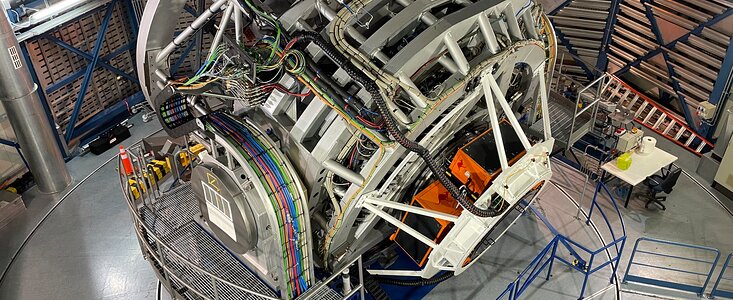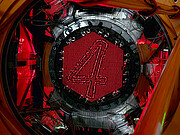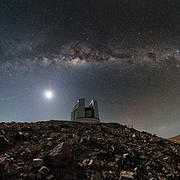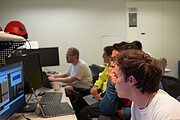Anuncio
Miles de ojos en el cielo: primera luz de 4MOST
21 de Octubre de 2025
Durante el fin de semana, 4MOST (4-metre Multi-Object Spectroscopic Telescope o Telescopio Espectroscópico Multi-objeto de 4 metros), concluyó con éxito sus primeras observaciones de prueba. El 4MOST, instalado en VISTA (Visible and Infrared Survey Telescope for Astronomy o Telescopio de Rastreo en lo Visible e Infrarrojo para la Astronomía), un telescopio ESO en Chile, es la instalación más grande de su tipo para inspeccionar los cielos del sur. Se espera que capte y analice la luz de más de 25 millones de objetos diferentes durante sus primeros cinco años de funcionamiento, para desentrañar la historia de nuestra galaxia, explorar los misterios de la materia oscura e investigar los orígenes de las estrellas, entre muchos otros objetivos científicos.
Este instrumento está diseñado para captar la luz de miles de objetos cósmicos simultáneamente, utilizando más de 2.400 fibras ópticas finas, cada una del ancho de un cabello humano. Esta luz luego se dirige a tres espectrógrafos independientes que la dividen en hasta 18.000 componentes de color (en el rango de luz visible desde violeta a rojo), y nos entregan espectros individuales. Con estos, los astrónomos pueden analizar las propiedades de las fuentes cósmicas observadas, incluida su composición química, velocidad o distancia.
“Los astrónomos han estado pidiendo una instalación como 4MOST desde hace mucho tiempo”, dice Joar Brynnel, director de proyectos de 4MOST del Instituto Leibniz de Astrofísica de Potsdam (AIP), Alemania, el instituto que lideró el consorcio del instrumento. El número de objetos que puede observar al mismo tiempo, el gran campo de visión (equivalente al área de 16 lunas llenas) y el gran número de colores espectrales que puede registrar simultáneamente hacen que el instrumento sea extraordinariamente único.
“Este es un cambio importante en las cosas que hacemos en ESO, normalmente cuando observas con un instrumento, observas objetivos para un estudio científico a la vez”, dice Vincenzo Mainieri, científico del proyecto de ESO para 4MOST. Sin embargo, debido al gran número de fibras, el instrumento puede observar fuentes de muchos proyectos científicos diferentes simultáneamente. Mainieri agrega: “4MOST puede servir a 10 o más estudios científicos en paralelo en una sola observación. Esta es una forma de maximizar la producción científica del instrumento”.
Esta instalación de vanguardia no solo arrojará luz sobre nuestra propia galaxia, sino que también mirará más allá hacia múltiples galaxias para reconstruir cómo se forman y evolucionan. Al observar galaxias distantes, 4MOST también nos ayudará a comprender mejor la materia oscura, una forma invisible de materia que impregna las galaxias y el espacio entre ellas. El instrumento también se utilizará para estudiar la evolución del universo en sí mismo, e investigará cómo se expande y cambia con el tiempo.
4MOST ha sustituido a la cámara infrarroja de VISTA (VIRCAM), que llevaba realizando inspecciones para el telescopio VISTA desde 2008. Dado que 4MOST es un espectrógrafo, un instrumento que es radicalmente diferente de una cámara, VISTA debía actualizarse completamente para recibirlo. “Tuvimos que sustituir muchos componentes del telescopio para lograr encajar nuestro instrumento, incorporando nuevos sistemas ópticos grandes al telescopio, nuevas cámaras técnicas para controlar el telescopio y el propio instrumento”, dice Brynnel. "La actualización del telescopio VISTA para recibir los nuevos componentes fue preparada por ESO antes de la llegada de 4MOST”, explica Jean-François (Jeff) Pirard, director de proyectos de ESO para 4MOST “El telescopio se volvió a poner en servicio durante el primer semestre de 2025 justo a tiempo para recibir el nuevo instrumento 4MOST”.
Las observaciones de primera luz de 4MOST, que abarcaron un área del cielo que incluyó la Galaxia del Escultor y el cúmulo estelar NGC288, ponen de manifiesto la capacidad de este instrumento de vanguardia para observar múltiples objetivos con un campo de visión asombrosamente amplio y su gran número de fibras ópticas. En la primera ejecución, 4MOST capturó espectros de varias estrellas en nuestra Vía Láctea y de más de mil galaxias cerca y lejos, demostrando sus impresionantes capacidades.
Roelof de Jong, investigador principal de 4MOST y jefe de sección Vía Láctea en AIP, comenta: “Es increíble ver los primeros espectros de nuestro nuevo instrumento. Los datos se ven fantásticos desde el principio y son un buen presagio para todos los diferentes proyectos científicos que queremos ejecutar. Que podamos captar la luz que ha viajado a veces durante miles de millones de años luz en una fibra de vidrio del tamaño de un cabello es alucinante. Una hazaña increíble que solo es posible gracias a un increíble equipo de desarrollo. No puedo esperar a que el sistema esté funcionando todas las noches”.
Más información
La instalación 4MOST ha sido diseñada, construida y operada científicamente por un consorcio de 30 universidades e institutos de investigación en Europa y Australia bajo la dirección del Instituto Leibniz de Astrofísica de Potsdam (AIP). Los principales institutos involucrados en la construcción y operación de esta instalación son:
- Instituto Leibniz de Astrofísica de Potsdam (AIP), Alemania
- Universidad de Macquarie / Australian Astronomical Optics (AAO), Australia
- Centro de Investigaciones Astrofísicas de Lyon (CRAL), Francia
- Observatorio Europeo Austral (ESO)
- Instituto Max Planck de Astronomía (MPIA), Alemania
- Instituto Max Planck de Física Extraterrestre (MPE), Alemania
- Escuela de Investigaciones Astronómicas de los Países Bajos (NOVA), Países Bajos
- Universidad de Cambridge, Instituto de Astronomía (IoA), Reino Unido
- Universidad de Hamburgo (UHH), Observatorio de Hamburgo, Alemania
- Universidad de Heidelberg, Centro de Astronomía (ZAH), Alemania
Enlaces
- Comunicado de prensa de AIP sobre la primera luz de 4MOST
- Sitio web del consorcio 4MOST
- Página de 4MOST en el sitio web público de ESO
- Más información sobre 4MOST en el blog de ESO.
- Primera luz de 4MOST (video AIP)
Contactos
Bárbara Ferreira
ESO Media Manager
Garching bei München, Germany
Tel: +49 89 3200 6670
Email: press@eso.org
Sobre el anuncio
| Identificador: | ann25007 |
Our use of Cookies
We use cookies that are essential for accessing our websites and using our services. We also use cookies to analyse, measure and improve our websites’ performance, to enable content sharing via social media and to display media content hosted on third-party platforms.
ESO Cookies Policy
The European Organisation for Astronomical Research in the Southern Hemisphere (ESO) is the pre-eminent intergovernmental science and technology organisation in astronomy. It carries out an ambitious programme focused on the design, construction and operation of powerful ground-based observing facilities for astronomy.
This Cookies Policy is intended to provide clarity by outlining the cookies used on the ESO public websites, their functions, the options you have for controlling them, and the ways you can contact us for additional details.
What are cookies?
Cookies are small pieces of data stored on your device by websites you visit. They serve various purposes, such as remembering login credentials and preferences and enhance your browsing experience.
Categories of cookies we use
Essential cookies (always active): These cookies are strictly necessary for the proper functioning of our website. Without these cookies, the website cannot operate correctly, and certain services, such as logging in or accessing secure areas, may not be available; because they are essential for the website’s operation, they cannot be disabled.
Functional Cookies: These cookies enhance your browsing experience by enabling additional features and personalization, such as remembering your preferences and settings. While not strictly necessary for the website to function, they improve usability and convenience; these cookies are only placed if you provide your consent.
Analytics cookies: These cookies collect information about how visitors interact with our website, such as which pages are visited most often and how users navigate the site. This data helps us improve website performance, optimize content, and enhance the user experience; these cookies are only placed if you provide your consent. We use the following analytics cookies.
Matomo Cookies:
This website uses Matomo (formerly Piwik), an open source software which enables the statistical analysis of website visits. Matomo uses cookies (text files) which are saved on your computer and which allow us to analyze how you use our website. The website user information generated by the cookies will only be saved on the servers of our IT Department. We use this information to analyze www.eso.org visits and to prepare reports on website activities. These data will not be disclosed to third parties.
On behalf of ESO, Matomo will use this information for the purpose of evaluating your use of the website, compiling reports on website activity and providing other services relating to website activity and internet usage.
Matomo cookies settings:
Additional Third-party cookies on ESO websites: some of our pages display content from external providers, e.g. YouTube.
Such third-party services are outside of ESO control and may, at any time, change their terms of service, use of cookies, etc.
YouTube: Some videos on the ESO website are embedded from ESO’s official YouTube channel. We have enabled YouTube’s privacy-enhanced mode, meaning that no cookies are set unless the user actively clicks on the video to play it. Additionally, in this mode, YouTube does not store any personally identifiable cookie data for embedded video playbacks. For more details, please refer to YouTube’s embedding videos information page.
Cookies can also be classified based on the following elements.
Regarding the domain, there are:
- First-party cookies, set by the website you are currently visiting. They are stored by the same domain that you are browsing and are used to enhance your experience on that site;
- Third-party cookies, set by a domain other than the one you are currently visiting.
As for their duration, cookies can be:
- Browser-session cookies, which are deleted when the user closes the browser;
- Stored cookies, which stay on the user's device for a predetermined period of time.
How to manage cookies
Cookie settings: You can modify your cookie choices for the ESO webpages at any time by clicking on the link Cookie settings at the bottom of any page.
In your browser: If you wish to delete cookies or instruct your browser to delete or block cookies by default, please visit the help pages of your browser:
Please be aware that if you delete or decline cookies, certain functionalities of our website may be not be available and your browsing experience may be affected.
You can set most browsers to prevent any cookies being placed on your device, but you may then have to manually adjust some preferences every time you visit a site/page. And some services and functionalities may not work properly at all (e.g. profile logging-in, shop check out).
Updates to the ESO Cookies Policy
The ESO Cookies Policy may be subject to future updates, which will be made available on this page.
Additional information
For any queries related to cookies, please contact: pdprATesoDOTorg.
As ESO public webpages are managed by our Department of Communication, your questions will be dealt with the support of the said Department.








